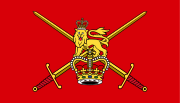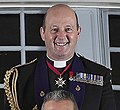|
Royal Army Chaplains' Department
The Royal Army Chaplains' Department (RAChD) is an all-officer department that provides ordained clergy to minister to the British Army. History
The Army Chaplains' Department (AChD) was formed by Royal Warrant of 23 September 1796;[1] until then chaplains had been part of individual regiments, but not on the central establishment. Only Anglican chaplains were recruited until 1827, when Presbyterians were recognised, but not commissioned until 1858.[2] Roman Catholic chaplains were recruited from 1836, Methodist chaplains from 1881, and Jewish chaplains from 1892.[3] During the First World War some 4,400 Army Chaplains were recruited and 179 lost their lives on active service.[3] The department received the "Royal" prefix in February 1919.[3] During the Second World War another 96 British and 38 Commonwealth Army Chaplains lost their lives.[3] From 1946 to 1996, the RAChD's Headquarters, Depot and Training Centre were at Bagshot Park in Surrey, now the home of The Duke and Duchess of Edinburgh.[4] In 1996, they moved to the joint service Armed Forces Chaplaincy Centre at Amport House near Andover, Hampshire.[5] Since 2020[6] the joint centre has been based at Beckett House, part of the Defence Academy of the United Kingdom, just outside Shrivenham, Oxfordshire.[7] In November 2023, the Ministry of Defence announced the intent to recruit Non-Religious Pastoral Support Officers into chaplaincy in order to reflect the changing demographics of the United Kingdom and HM Forces.[8] RoleServing regular chaplains in the British Army can be Catholic, one of several Protestant denominations, or to the Jewish faith. Uniquely within the Army, the Royal Army Chaplains' Department has different cap badges for its Christian and Jewish officers.[9] Army chaplains, although they are all commissioned officers of the British Army and wear uniform, do not have executive authority. They are unique within the Army in that they do not carry arms. Many chaplains have been decorated for bravery in action, including four awarded Victoria Crosses: James Adams, Noel Mellish, Theodore Hardy and William Addison.[10] At services on formal occasions, chaplains wear their medals and decorations on their clerical robes.[11] The RAChD's motto is "In this Sign Conquer" as seen in the sky before the Battle of the Milvian Bridge by the Roman Emperor Constantine. Its regimental march, both quick and slow, is the Prince of Denmark's March, erroneously known as the Trumpet Voluntary.[12] MuseumThe Royal Army Chaplains' Museum is at Shrivenham, in a new building opened by the Countess of Wessex on 17 May 2022.[13] Its newly curated collection replaced the Museum of Army Chaplaincy which was at Amport House near Andover, Hampshire until 2019.[14] Faith denominations and belief backgroundsChaplains are either classified as Jewish, a member of one of the following denominational Christian groups, a member of World Faiths or a Non-religious Pastoral Provider:[15]
There are also religious advisors from other faiths.[16] An Army chaplain is expected to minister to and provide pastoral care to any soldier who needs it, no matter their denomination or faith or lack of it.[17] In 2004, Defence Minister Ivor Caplin said: “It is our aspiration to have armed forces which are representative of UK society as a whole.” The move might also help when dealing with soldiers in other armies from different faiths. At the time there were about 740 personnel that declared themselves to be from the four other main religions, but only Christian chaplains are employed by the Ministry of Defence. The number of non religious Ministry of Defence personnel including those in uniform numbered in the tens of thousands.[18] In 2011, following a freedom of information request on Ministry of Defence spending on chaplaincy, the National Secular Society proposed that £22m of spending should come directly from churches while professional counselling should continue to be funded by the taxpayer,[19] in order to better serve the non-religious in the military.[20] The proposal was rejected by the Church of England.[19] In September 2021, Defence Humanists, through a submission to the Government’s Integrated Review of foreign policy, defence, security and international development, called for an independent review of pastoral support for the armed forces which takes into account the nation’s changing religion and belief demographics and the need for a multi-faith and belief approach.[21] In November 2023, the Ministry of Defence announced the intent to recruit Non-Religious Pastoral Support Officers into chaplaincy in order to reflect the changing demographics of the United Kingdom and HM Forces.[8] The armed forces of the Netherlands have had Humanist chaplains since 1964, known as Humanist Counseling in the Dutch Armed Forces.[22] Ranks Chaplains are the only British Army officers who do not carry standard officer ranks. They are instead designated Chaplain to the Forces (CF) (e.g. "The Reverend John Smith CF"). They do, however, have grades which equate to the standard ranks and wear the insignia of the equivalent rank. Chaplains are usually addressed as "Padre" /ˈpɑːdreɪ/, never by their nominal military rank.
The senior Church of England chaplain is ranked within the church hierarchy as an archdeacon, and he or she holds the appointment of Archdeacon for the Army whether or not he or she is also the Chaplain-General. The senior Roman Catholic Chaplain (usually a CF1) is sometimes ranked as a monsignor.[23] List of Chaplains General
Deputy Chaplains General
Order of precedenceNotable British Army chaplains
Gallery
See also
Footnotes
Sources
Further reading
External links
|
|||||||||||||||||||||||||||||||||||||||||||||||||||||||||||||||||||||||||||||||||||||||||||||||||||||||||||||||||||||||||||||||||||||||||||||||||||||||||||||||||||||||||||||||||||||||||||||||||||||||||||||||||||






